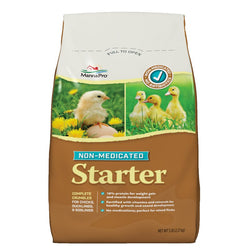What are the signs of mites or lice and how do I treat my birds if they have an infestation?
Back to blog
Signs of parasite infestation in your flock's feathers
Mites inhabit your birds' feathers and suck their blood: they're like fleas, lice, or mosquitoes that live in your hair---yuck!Infestations of feather mites or lice can cause a reduction in laying, pale combs and wattles, anemia and even death! Infestations can also cause feather loss, usually on the back, because a bird may over-preen and pluck her own feathers in an attempt to get relief. It is similar to the loss of feathers caused by too much attention from a rooster. However, a rooster normally causes broken feathers, at least at first, whereas mites can cause feather loss down to the skin quickly--sometimes the skin is irritated and red! If you have mites or lice, you will need to treat your birds. But luckily, the types of lice and most mites that affect birds are not interested in humans.
A mite is so tiny, it's hard to see, and some types of mites only come out at night. If you have good vision, you may be able to see them around your bird's vent or beneath her wings, especially if your bird has light colored feathers (easier to see the mites against). Lice are larger, but they're lighter colored, too--they're nearly as hard to spot as mites.
There are a number of reasons your chickens might not be laying, though, so if you suspect there's something more to the drop or cessation of laying than mites---or if you've checked very carefully and have not spotted any---have a look at this list of other possible reasons your chickens aren't laying.
Treating your chickens for mites or lice
There are various treatments for these avian parasites, but many involve using a pesticide dust or spray on your birds. This sounds sort-of terrifying, but think of it like a flea dip for birds.If your infestation is severe, you may want to use a pesticide that will kill them on contact to provide your birds relief. The dust treatment is nice, because chickens usually enjoy the feeling of dust in their feathers. Be careful when applying, though, that neither you nor your birds breathe it in. Be aware that your birds may decide to react to your kind ministrations by flapping their wings vigorously, making a real dust cloud, so be sure to hold them firmly. For application, we've used old spice shakers (clearly marked POISON). Other people prefer to fill a toe from an old pair of ladies hose with the powder and pat it on that way: the dust is so fine it filters through like a powder puff.
But why use pesticides if you don't have to? Do consider one of the great NON-pesticide treatments. One spray uses essential oils to kill the parasites, and another spray uses a special type of salt used as a food additive to kill the parasites.
For a non-chemical dust, diatomaceous earth and First Saturday Lime can help prevent and treat some types of mites and lice, however it works slowly by drying the bugs out. We do recommend using a few handfuls of DE in your birds' dusting areas to help prevent infestations from taking hold in the first place.
When you apply your treatment, no matter which you choose, pay particular attention to the areas around their vents and beneath their wings. If you have a rooster, make absolutely sure to treat him thoroughly. If your rooster has mites, he will spread it back around to the rest of your girls!
Scaly Leg Mites
Scaly leg mites can also cause problems for your birds, but they are treated differently from parasites that infest feathers. Your birds may have scaly leg mites if you notice the scutes (the scales on their legs) begin to lift up. This is caused by the mite waste building up beneath; it is painful and eventually debilitating for your birds.
Here's how to treat for scaly leg mites: on your birds' legs, rub petroleum jelly or even an antibiotic ointment that uses petroleum jelly as a base. Some people prefer to use oil, or even something like a Pam cooking spray. You'll have to treat every two or three days for several weeks, and the scales may not return to normal.
Some people recommend treating scaly leg mites with things like WD-40, but that's a bad idea. WD-40 has strong fumes that the manufacturers warn can cause respiratory irritation, so it is bad for your birds' lungs and respiratory system. In addition WD-40 carries a caution recommendation that if it comes into contact with your skin, it should be immediately washed off. Purposeful application of this product to your birds is a very bad idea---don't listen to anyone who tells you to treat your birds with this product!











